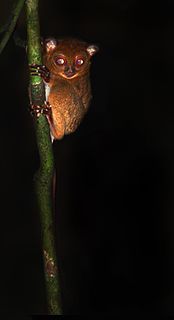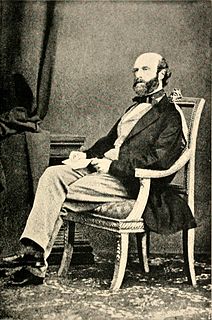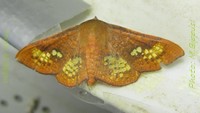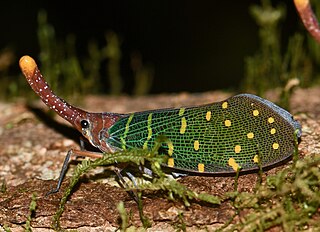
James Wood-Mason was an English zoologist. He was the director of the Indian Museum at Calcutta, after John Anderson. He collected marine animals and lepidoptera, but is best known for his work on two other groups of insects, phasmids and mantids.

Horsfield's tarsier, also known as the western tarsier, is the only species of tarsier in the genus Cephalopachus. It occurs on Borneo, Sumatra and nearby islands and is, like other members of the group, entirely nocturnal.

Francis Walker was an English entomologist. He was born in Southgate, London, on 31 July 1809 and died at Wanstead, England on 5 October 1874. He was one of the most prolific authors in entomology, and stirred controversy during his later life as his publications resulted in a huge number of junior synonyms.

Alexander Henry Haliday was an Irish entomologist. He is primarily known for his work on Hymenoptera, Diptera, and Thysanoptera, but worked on all insect orders and on many aspects of entomology.

The Lauxaniidae are a family of acalyptrate flies. They generally are small flies with large compound eyes that often are brightly coloured in life, sometimes with characteristic horizontal stripes, such as in Cestrotus species. Many species have variegated patterns on their wings, but in contrast they generally do not have variegated bodies, except for genera such as Cestrotus, whose camouflage mimics lichens or the texture of granitic rocks.

The lesser false vampire bat is a bat found in South Asia and Southeast Asia from Sri Lanka and India in the west to Indonesia and the Philippines in the east. They live in caves and tree hollows. They are insectivorous.

Mount Pueh, also known as Mount Pueh-Berumput, Mount Poi and Mount Poe, is a mountain located near Lundu, Sarawak on the Malaysia-Indonesia border. Mount Pueh was known to biologists for the collections made there by Eric Mjöberg (1882–1938), a Swedish naturalist, who was Curator of the Sarawak Museum between 1922–1924. Mjöberg's herpetological collections from Gunung Pueh between October to December 1923, and other localities in Borneo, were reported by Smith (1925). Mjöberg, unfortunately, left little by way of written records, of his ascent of Pueh and the collections he made.
Arotrophora arcuatalis, commonly known as banksia boring moth or rarely banksia moth, is a species of Australian tortrid moth best known as a pest of Banksia.

Heliothis punctifera or the lesser budworm, is an Australian moth of the family Noctuidae; one of the most migratory families of insects. It is considered a pest species to agricultural crops, however, due to its inland habitat, is found to be less damaging to agricultural areas than other species of the genus.
Ligidia is a monotypic moth genus of the family Noctuidae. Its only species, Ligidia decisissima, is found in Borneo. Both the genus and species were first described by Francis Walker in 1862.

Pyralis pictalis, the painted meal moth or poplar pyralis, is a snout moth. It is closely related to the family's type species the meal moth and consequently belongs to the tribe Pyralini of the snout moth subfamily Pyralinae. Its native range is tropical Asia to East Asia and to Wallacea and adjacent regions, but it has been quite widely distributed by humans. The term "Poplar" in its common name does not refer to the trees, but to Poplar, London, where the type specimen – from such an introduction – was caught. It was called scarce meal moth in the original description, which is only correct for the fringes of its range however.

Planotortrix excessana, the greenheaded leafroller, is a moth of the family Tortricidae. It is native to New Zealand and is an introduced species in Hawaii. It is extremely variable in appearance and feeds on many native and introduced species. It is regarded as a pest of some agricultural and forestry crops.

Scirpophaga incertulas, the yellow stem borer or rice yellow stem borer, is a species of moth of the family Crambidae. It was described by Francis Walker in 1863. It is found in Afghanistan, Nepal, north-eastern India, Sri Lanka, Bangladesh, Myanmar, Vietnam, Thailand, Malaysia, Singapore, Sumatra, Java, Borneo, Sumba, Sulawesi, the Philippines, Taiwan, China and Japan.

Banisia is a genus of moths of the family Thyrididae.
Melanostoma fasciatum is a species of hoverfly found in New Zealand, where it is common in agricultural fields and gardens. Locally dense populations of this hoverfly species might effectively reduce pest infestation. Hence, they are perhaps an effective natural and non-toxic bioagent that may control and reduce aphid and small caterpillar populations.

Eudonia sabulosella is a species of moth in the family Crambidae. This species is endemic to New Zealand and is regarded as being common. The larvae of this species are known to damage pasture in New Zealand.

Musgraveia sulciventris is a large stink bug found in Australia, sometimes known as the bronze orange bug but more often "stink bug". It is considered a pest, particularly to plants in the citrus group. They suck the sap from trees, which causes the flowers and fruit to fall.
Cromna is a genus of fulgoroid planthoppers in the family Flatidae. It was described by Francis Walker in 1857.

Brachyanax is a genus of bee fly in the subfamily Anthracinae. It was circumscribed by Neal Evenhuis in 1981. Thirteen species are recognized, and they are found in Asia and Australasia.

Pyrops intricatus is a species of lantern bug, an insect in the family Fulgoridae, found in Borneo. It was originally described in 1857 by Francis Walker as Hotinus intricatus.
















